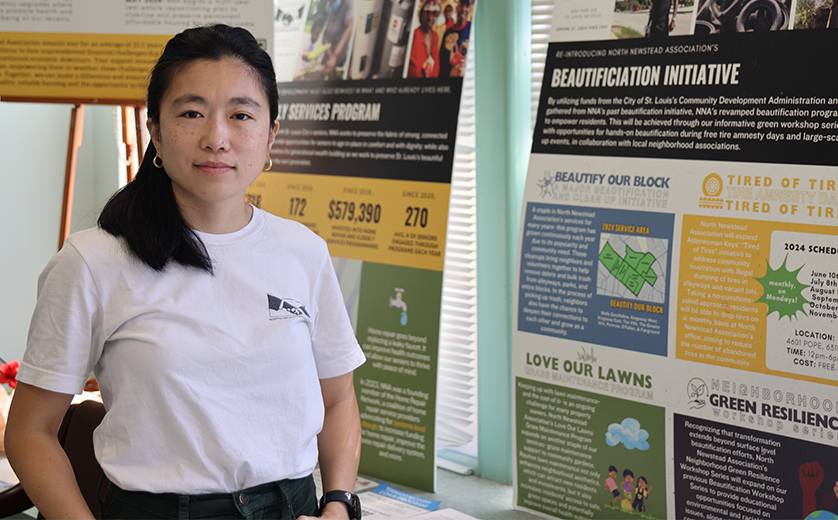On a bright October afternoon, sunlight filters through the blinds of a small office in North St. Louis. Inside the North Newstead Association, the phones are unusually quiet. A rare moment of calm, said Executive Director Constance Siu, MSW ’17.
Nearly six months after a devastating tornado tore through St. Louis, hitting North City especially hard, Siu and her small staff are still helping neighbors rebuild their lives.
“Remember that May 16 still happened this year, and it’s still affecting a lot of people,” she said. “Once you drive into the south of the city, it’s easy to forget the tornado ever happened. But we still have so many residents who don’t have a place to live, who are not in a dry structure at night, who are living in their cars and hotels.”
The North Newstead Association (NNA) is a not-for-profit corporation designated by the City of St. Louis as a Community Based Development Organization. It’s located in the Penrose neighborhood just south of O’Fallon Park, and serves 23 neighborhoods across North St. Louis City. For 32 years, it has focused on providing affordable housing while building community connections through beautification projects, elderly services, and home repairs. The association currently owns and operates 138 affordable housing units across more than 30 buildings.
“Affordable housing is our bread and butter,” Siu said. “We’ve been an affordable housing developer since we were created. But over the last decade, we’ve also expanded our community-building programs that connect neighbors.”
These programs include neighborhood cleanups, tire amnesty days, senior engagement activities, and home repair assistance, often in partnership with neighborhood associations and the city.
After the storm
When the tornado struck in May, Siu and her two-person staff: Casey Ringenberg, MSW ’22, NNA’s community engagement manager and a Brown School alumna, and Kevin Green, the home repair manager, were out of the office, but quickly returned. By 5 p.m., they were back, assessing damage, checking on tenants and fielding calls.
All of the association’s properties sustained some level of damage, with nine buildings significantly affected. Sixteen families were immediately displaced, though Siu said there were no fatalities and only minor injuries. In the days after the storm, the team shifted into emergency response mode, clearing debris, boarding windows, and tarping roofs. As the crisis eased, they helped tenants navigate FEMA applications, insurance claims, and temporary housing. A social work practicum student who started the day after the storm became instrumental in helping displaced residents connect with housing resources.
In August, the association hosted a tornado rebuilding workshop to help residents rebuild safely and avoid contractor scams. The session also addressed financial options for underinsured homeowners, an issue the tornado made painfully clear by exacerbating long-standing challenges.
“The tornado exposed the scars and the inequities that have existed throughout the history of St. Louis,” Siu said. “We already knew people were underinsured and that home repair needs were mounting.” The storm, she added, highlighted the urgency of addressing infrastructure issues in St. Louis and protecting and supporting existing communities.
Recovery remains ongoing
Nearly six months later, recovery is ongoing. Tarps still flap on roofs. Windows remain boarded. Tree stumps line O’Fallon Park where mature trees once stood. Most displaced families have not returned home. Only one family has been rehoused within NNA’s properties, while many others continue to stay with relatives or in hotels.
“Thousands of North St. Louis residents still don’t have homes,” Siu said. “We need to think creatively about housing. Maybe that means opening shelters in places we haven’t before or rethinking how we use vacant buildings. We really need to work together as a region to make sure we’re not leaving folks behind.”
Meanwhile, with winter approaching, Siu worries about residents without stable housing.
“It’s scary to think about how bad our winters have been, and about existing issues with how our unhoused folks have not been served,” she said. “Now, layering thousands of other people on top of that population, we have to ask: how can we make sure that we’re not going to allow more people to die because of the May 16 tornado?”
But, despite the challenges, Siu remains hopeful.
“I’m optimistic because the community did turn out immediately after the storm,” she said. “I think there’s a general interest within all of St. Louis to see North St. Louis recover and rebuild.
When asked what a realistic recovery looks like for St. Louis, Siu paused. “That’s a big question, and not one that I have an answer to,” she said. “But I know that whatever it looks like, it has to be done with community.”
